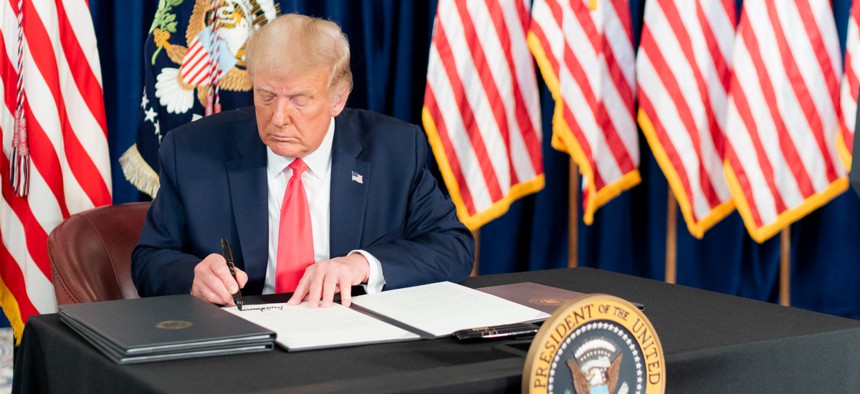
White House Photo
Trump Said ‘I Alone Can Fix’ Government. He Failed.
If Biden is elected, he has to give it a try—quickly.
Donald Trump became president promising no tolerance for government incompetence, no sympathy for leaders who fail their citizens, and no qualms about cutting the federal workforce. Four years later, he heads toward election day with a record amount of government breakdowns, rising levels of bureaucratic bloat, and a near-record number of federal employees under his command—most of whom are hidden from public view through contracts and grants.
As for his promise that “I alone can fix” the nation’s problems, the public’s demand for very major government reform is near a 20-year high, according to surveys by the Pew Research Center, Princeton Survey Research Associates, and SSRS. (The 2016, 2018, and 2019 surveys reflected below were funded by the Volcker Alliance, as was much of the earlier research discussed in this article.)

Consider the Trump administration’s record-setting number of highly visible government breakdowns, which now includes the recent White House COVID-19 super-spreader event. Trump promised to run the government under budget and on schedule, but his administration has produced a long list of breakdowns caused by poor planning, failures to act, administrative confusion, and sluggish responses to Hurricane Maria and the COVID-19 pandemic.
Trump often blames the “deep state” and Democratic sabotage for his long list of failures. But the number of breakdowns, as determined by surveys of public interest in major stories and investigations of federal government performance, is well above average compared to his predecessors. Ronald Reagan, George H. W. Bush, and Bill Clinton together averaged just 1.5 breakdowns per year, and George W. Bush and Barack Obama averaged 3.3. Trump has averaged 5.25 annually to date. He also just set a single-year record with nine breakdowns in 2020—with three months left to go.

Tempting though it might be to tie all breakdowns to the president in office at the time, the post-2001 increase is a predictable result of the recent drought in bureaucratic reform. It has been 50 years since the last round of civil service and ethics reform, 40 years since presidents lost their reorganization authority, and 25 since Vice President Al Gore’s reinventing government campaign. Along the way, policies became more complex, the bureaucracy hardened, and the civil service continued to trail the private sector on the resources needed to get the job done.
Second, Trump has raised the amount of high-level bureaucracy to its highest mark dating back to 1960. Instead of cutting the number of “people over people over people” that he described as “totally unnecessary,” Trump has added more layers of leaders at the top of government than any president in recent history. According to directories of federal leaders, the Trump administration increased the number of layers at the top of government from 71 in 2017 to 83 today, while boosting the number of people over people by 50%, from 3,200 to 4,900. As the bloat has increased, so has the distortion of information, as it moves up and down a muddled chain of command.

Third, Trump has overseen a 25% increase in the federal government’s blended workforce of civil servants, active duty military service members, postal workers, contractors and grant-funded employees. Trump promised to run the federal government with fewer people at a lower cost, but excluded contract- and grant-funded employees from the headcounts.
Although the number of full-time federal employees has remained remarkably stable for years, it masks the addition of 1.4 million employees who work for the federal government under contracts and another 600,000 who work under grants. Fueled by large increases in defense and transportation spending, and a slight rise in the number of civil servants, the blended workforce reached a near-record high in 2019 and shows no signs of slowing down.

Trump was an unabashed advocate of this growth. Although he has claimed that the Pentagon increased its contracting budget to keep the defense industry “happy,” Trump entered office promising a “historic” increase in military spending and has more than honored his pledge. Trump has extolled the jobs created by defense contracts and signed off on the infrastructure grants that anchored his version of the 2009 stimulus package he often derides.
Trump’s mismanagement deserves closer attention if only because the breakdowns, bloat and overpromising reinforce the public's demand for major government reform. Americans are deeply divided along party lines, but three out five say the federal government is almost always wasteful and inefficient, does a poor job running its programs and can’t be trusted to do the right thing. Two-thirds say the U.S. system of government either needs major structural repairs or should be completely replaced.
Joe Biden has tried to make Trump’s mismanagement a campaign issue, but he must do much more than just criticize the president’s failures. He must also offer a detailed agenda on how he will repair the broken federal agencies and operations he will inherit. At least for now, however, Biden and his supporters still seem to believe the federal government will automatically bounce back when Trump leaves town. Biden himself has promised just such an epiphany in congressional comity—and swears it’s “not a joke.” Biden does not want for new policy ideas, but is desperately short on blueprints for bureaucratic reform.
The problems facing federal agencies demand more than Trump’s exit, even if few of the president’s appointees will be missed. Nor will tighter ethics and campaign finance laws be enough to reverse the bureaucratic decay. Absent aggressive reorganizations and a “fix-it-fast” repair plan for broken agencies such as the Centers for Disease Control, the recent surge in breakdowns will continue and Biden’s build-it-back-better agenda will be lost.
Biden’s base of supporters may want more of almost everything the federal government delivers, but they should also demand significant bureaucratic repairs as part of the deal. Biden would be well advised to revisit Jimmy Carter’s good-government agenda from 1977. He might also borrow from Carter’s acceptance speech promising to honor the “majesty of the Constitution,” “lead without negativism,” and tear down the wall between government and the people.
It was the perfect message for a nation recovering from turmoil and still resonates today. Biden would be wise to embrace Carter’s themes, but must move quickly once in office. If the past is any guide, his first government breakdown will arrive by June 2021.
Paul C. Light is a professor at NYU’s Wagner School of Public Service. Further exploration of the trends in this article can be found on the Brookings Institution’s FixGov website.
NEXT STORY: Reforming Agencies to be Ready for the Future







